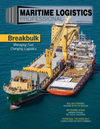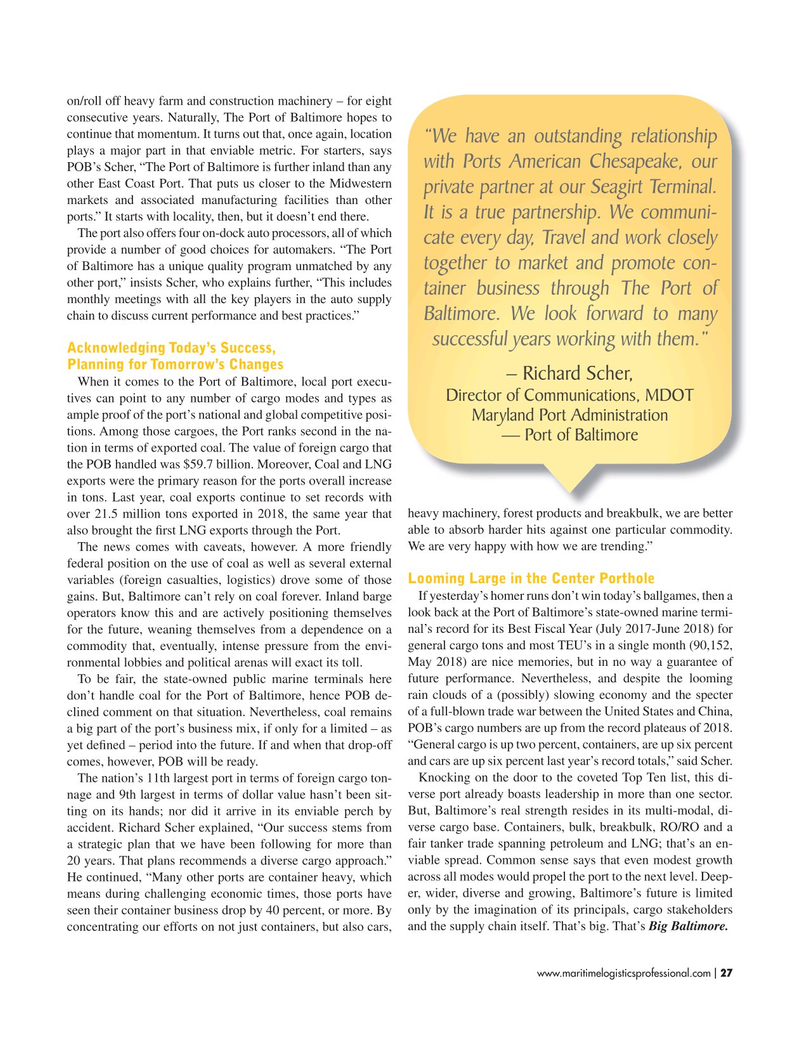
Page 27: of Maritime Logistics Professional Magazine (Jul/Aug 2019)
Breakbulk Issue
Read this page in Pdf, Flash or Html5 edition of Jul/Aug 2019 Maritime Logistics Professional Magazine
on/roll off heavy farm and construction machinery – for eight consecutive years. Naturally, The Port of Baltimore hopes to continue that momentum. It turns out that, once again, location “We have an outstanding relationship plays a major part in that enviable metric. For starters, says with Ports American Chesapeake, our
POB’s Scher, “The Port of Baltimore is further inland than any other East Coast Port. That puts us closer to the Midwestern private partner at our Seagirt Terminal. markets and associated manufacturing facilities than other
It is a true partnership. We communi- ports.” It starts with locality, then, but it doesn’t end there.
The port also offers four on-dock auto processors, all of which cate every day, Travel and work closely provide a number of good choices for automakers. “The Port together to market and promote con- of Baltimore has a unique quality program unmatched by any other port,” insists Scher, who explains further, “This includes tainer business through The Port of monthly meetings with all the key players in the auto supply chain to discuss current performance and best practices.”
Baltimore. We look forward to many successful years working with them.”
Acknowledging Today’s Success,
Planning for Tomorrow’s Changes – Richard Scher,
When it comes to the Port of Baltimore, local port execu-
Director of Communications, MDOT tives can point to any number of cargo modes and types as ample proof of the port’s national and global competitive posi-
Maryland Port Administration tions. Among those cargoes, the Port ranks second in the na- — Port of Baltimore tion in terms of exported coal. The value of foreign cargo that the POB handled was $59.7 billion. Moreover, Coal and LNG exports were the primary reason for the ports overall increase in tons. Last year, coal exports continue to set records with hhifddbkblkb over 21.5 million tons exported in 2018, the same year that heavy machinery, forest products and breakbulk, we are better also brought the ? rst LNG exports through the Port. able to absorb harder hits against one particular commodity.
The news comes with caveats, however. A more friendly We are very happy with how we are trending.” federal position on the use of coal as well as several external
Looming Large in the Center Porthole variables (foreign casualties, logistics) drove some of those gains. But, Baltimore can’t rely on coal forever. Inland barge If yesterday’s homer runs don’t win today’s ballgames, then a operators know this and are actively positioning themselves look back at the Port of Baltimore’s state-owned marine termi- for the future, weaning themselves from a dependence on a nal’s record for its Best Fiscal Year (July 2017-June 2018) for commodity that, eventually, intense pressure from the envi- general cargo tons and most TEU’s in a single month (90,152, ronmental lobbies and political arenas will exact its toll. May 2018) are nice memories, but in no way a guarantee of
To be fair, the state-owned public marine terminals here future performance. Nevertheless, and despite the looming don’t handle coal for the Port of Baltimore, hence POB de- rain clouds of a (possibly) slowing economy and the specter clined comment on that situation. Nevertheless, coal remains of a full-blown trade war between the United States and China, a big part of the port’s business mix, if only for a limited – as POB’s cargo numbers are up from the record plateaus of 2018. yet de? ned – period into the future. If and when that drop-off “General cargo is up two percent, containers, are up six percent comes, however, POB will be ready. and cars are up six percent last year’s record totals,” said Scher.
The nation’s 11th largest port in terms of foreign cargo ton- Knocking on the door to the coveted Top Ten list, this di- nage and 9th largest in terms of dollar value hasn’t been sit- verse port already boasts leadership in more than one sector. ting on its hands; nor did it arrive in its enviable perch by But, Baltimore’s real strength resides in its multi-modal, di- accident. Richard Scher explained, “Our success stems from verse cargo base. Containers, bulk, breakbulk, RO/RO and a a strategic plan that we have been following for more than fair tanker trade spanning petroleum and LNG; that’s an en- 20 years. That plans recommends a diverse cargo approach.” viable spread. Common sense says that even modest growth
He continued, “Many other ports are container heavy, which across all modes would propel the port to the next level. Deep- means during challenging economic times, those ports have er, wider, diverse and growing, Baltimore’s future is limited seen their container business drop by 40 percent, or more. By only by the imagination of its principals, cargo stakeholders concentrating our efforts on not just containers, but also cars, and the supply chain itself. That’s big. That’s Big Baltimore.
www.maritimelogisticsprofessional.com 27
I

 26
26

 28
28
